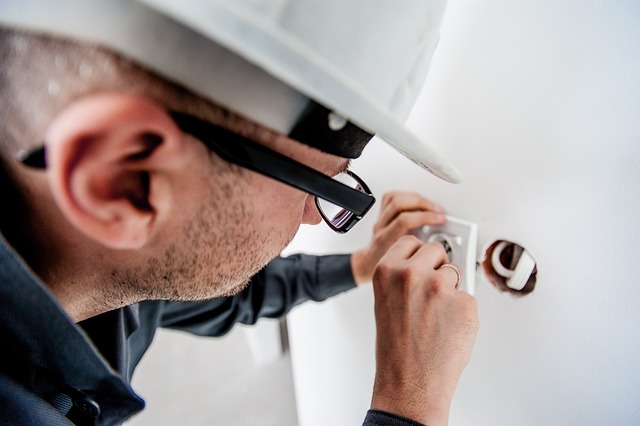Electricians play a crucial role in ensuring building code compliance and safety during inspections. They identify electrical hazards, verify critical components like panel boxes and fuses, and inspect outlets and fixtures for adherence to industry standards. A comprehensive inspection also covers structural elements, ventilation, fire safety (smoke detectors, alarms, extinguishers), access for disabilities, roofs, walls, floors, staircases, and exit routes. Regular testing of essential systems and meticulous attention to detail are vital for a safe and code-compliant building, with electricians being integral to this process.
When it comes to ensuring the safety and legality of a building, electricians play a pivotal role as key inspectors. Their expertise is crucial in identifying potential hazards and verifying code compliance. This article delves into the essential duties of an electrician during inspections, highlighting critical areas that demand meticulous attention. From electrical systems to structural integrity, we explore best practices for thorough building assessments, empowering professionals to maintain safe and code-compliant environments.
- Understanding the Role of an Electrician in Building Inspections
- Key Areas for Code Compliance and Safety Risk Assessment
- Best Practices for Comprehensive Building Inspections
Understanding the Role of an Electrician in Building Inspections

When conducting building inspections for code compliance and safety risks, electricians play a pivotal role. They are the experts who ensure that all electrical systems within a structure meet industry standards and pose no hazards. An electrician’s involvement is crucial during these inspections as they can identify potential issues like faulty wiring, outdated electrical panels, or improper grounding—problems that could lead to severe accidents or structural damage.
These professionals bring a wealth of knowledge about electrical safety protocols and regulations. They carefully inspect panel boxes, circuit breakers, and fuses, verifying their proper functioning and capacity. Moreover, they examine the installation of outlets, switches, and lighting fixtures, ensuring they are up to code and safe for use. By integrating the expertise of an electrician into building inspections, potential risks can be mitigated, enhancing the overall safety and livability of the structure.
Key Areas for Code Compliance and Safety Risk Assessment

When conducting a thorough inspection for code compliance and safety risks, several critical areas demand meticulous attention. One of the primary focuses should be the electrical system, as it is a fundamental aspect of any building’s infrastructure. A qualified electrician plays a pivotal role in evaluating the integrity of wiring, outlets, switches, and fixtures to ensure they meet current safety standards. Regular maintenance and updates are essential to prevent hazards like overloading, faulty connections, or outdated equipment that could lead to fires or electrical shocks.
Beyond electricity, structural elements like the roof, walls, floors, and staircases must be assessed for any signs of damage, wear, or non-compliance with local building codes. Proper ventilation and fire safety measures, including smoke detectors and fire extinguishers in working order, are also vital. Additionally, inspectors should check for accessibility and safety features like handrails on stairs, adequate lighting, clear exit routes, and compliance with disability access standards to ensure the building is safe and accessible for all occupants.
Best Practices for Comprehensive Building Inspections

Comprehensive building inspections require a systematic approach to ensure every aspect of the structure is evaluated for code compliance and potential safety hazards. Here are some best practices to consider: Start with a detailed review of the building’s electrical system, as it’s a critical component that directly impacts safety. A qualified electrician should assess wiring, outlets, switches, and any available emergency lighting systems. This initial step helps identify potential risks like outdated wiring or faulty installations, which could lead to serious consequences.
During the inspection, don’t overlook lesser-known areas such as the roof structure, plumbing vents, and fire protection systems. These elements are often overlooked but can pose significant risks if not properly maintained. Regularly inspect and test fire alarms, smoke detectors, and sprinkler systems to guarantee they’re functional. Additionally, pay close attention to the building’s exterior, checking for signs of water damage, structural weaknesses, or compromised safety features like handrails and guardrails.
In conclusion, electricians play a pivotal role in ensuring building safety through thorough code compliance inspections. By meticulously assessing key areas, they identify potential risks and ensure structures meet necessary safety standards. Adhering to best practices for comprehensive inspections is paramount, empowering electricians to make informed decisions and protect the well-being of occupants and communities alike.
